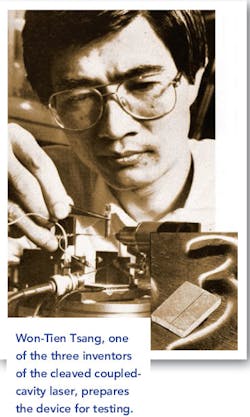This laser was created by Won-Tien Tsang, Anders Olsson, and Ralph Logan from AT&T Bell Labs' Semiconductor Electronics Research Department (see photo). Their cleaved coupled-cavity laser or "C3"comprised two standard Fabry-Perot cavity gallium-indium-arsenic-phosphide (GaInAsP) crescent laser diodes that were slightly different sizes. The diodes were aligned and closely coupled to form a two-cavity resonator that varied in length from 200 to 400 M.
The active stripes in each diode were positioned on a straight line, separated by less than 5 m. All reflecting facets were formed by cleaving along crystallographic planes. They were therefore mirror-flat and parallel to each other. The paired cavities, which were optically coupled, were electrically isolated to an equivalent resistance of 50 kΩ.
The character of the light emitted by the laser could be precisely controlled. Its refractive index could be adjusted by varying the input power to one part of the device independent of the other. While the C3 laser was operating, one diode provided a customary output spectrum. The other acted as a frequency modulator or filter.
The researchers explained that the carrier density of each active stripe could be changed by varying the injection current below threshold when the junction voltage was not saturated. Because the two cavities were coupled, the spectrally coinciding Fabry-Perot modes from each would interfere in a constructive manner: They would become the reinforced Fabry-Perot modes of the entire coupled-cavity resonator. Other modes were suppressed because they would interfere destructively.
Early on, the laser demonstrated error-free transmission at 1 Gb/s. Although the C3 concept could be applied to any wavelength, the laser was no bigger than the average semiconductor laser. It also boasted a very rapid tuning rate over a wide range of frequencies, thanks to a type of direct frequency modulation (FM) that the researchers dubbed "cavity-mode-enhanced frequency modulation" (CME-FM).
If, for example, the input power to Diode 2 was increased while the power to Diode 1 was kept the same, the change in carrier density of active Stripe 2 would decrease the effective refractive index. The modes of Diode 2 would then be shifted toward shorter wavelengths. As a result, the Fabry-Perot modes of the diodes would become misaligned. The adjacent mode on the shorter-wavelength side would come into alignment and be re-inforced. Thus, the C3 would shift one Fabry-Perot mode spacing toward the shorter wavelength.
Using a 13-m C3 laser, the team obtained a frequency tuning range of 150 Angstroms and a tuning rate of 10 V/mA. It was credited with great potential for system-upgrade techniques like frequency shift keying and wavelength division multiplexing. To Bell Labs, its greatest potential lay in powering single-mode, 1.5-m fiber-optic systems.
About the Author

Nancy Friedrich
RF Product Marketing Manager for Aerospace Defense, Keysight Technologies
Nancy Friedrich is RF Product Marketing Manager for Aerospace Defense at Keysight Technologies. Nancy Friedrich started a career in engineering media about two decades ago with a stint editing copy and writing news for Electronic Design. A few years later, she began writing full time as technology editor at Wireless Systems Design. In 2005, Nancy was named editor-in-chief of Microwaves & RF, a position she held (along with other positions as group content head) until 2018. Nancy then moved to a position at UBM, where she was editor-in-chief of Design News and content director for tradeshows including DesignCon, ESC, and the Smart Manufacturing shows.
